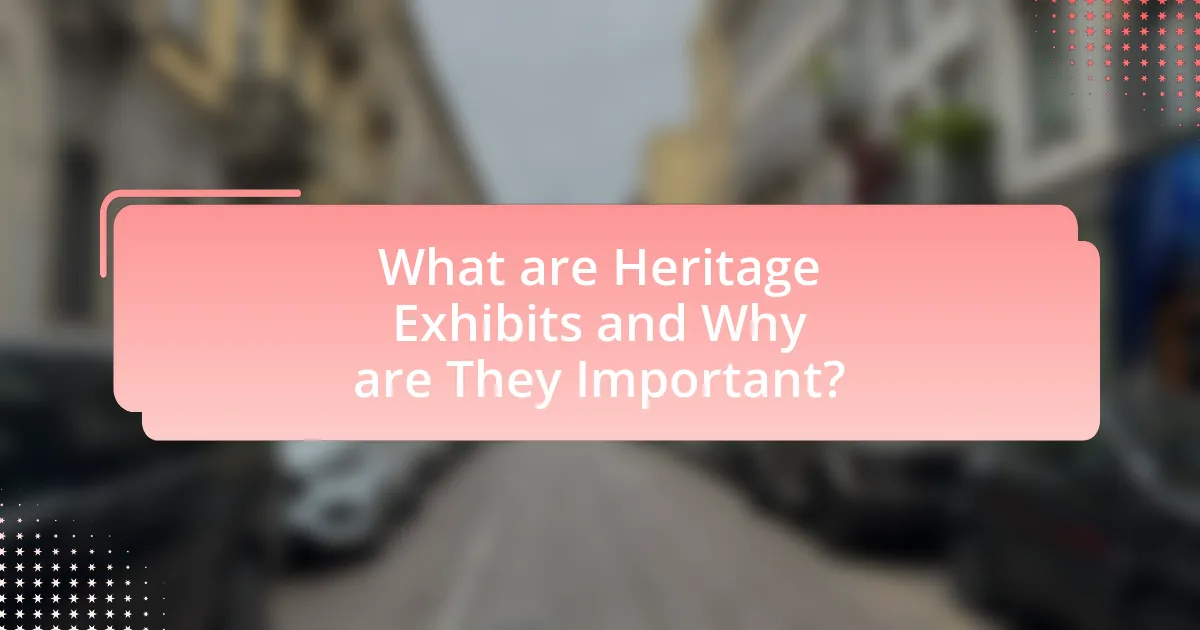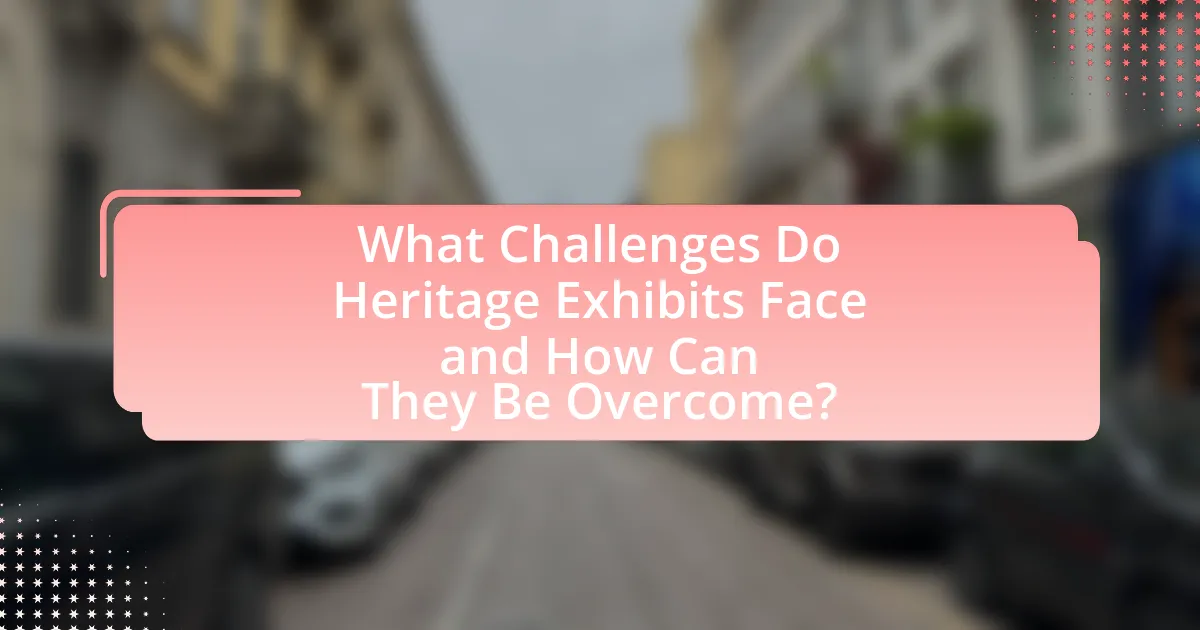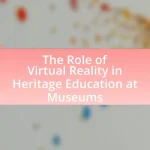Heritage exhibits are curated displays that highlight artifacts, traditions, and narratives from specific cultures or historical periods, playing a crucial role in cultural preservation, education, and community engagement. This article examines notable case studies of successful heritage exhibits worldwide, such as the Smithsonian Institution’s National Museum of African American History and Culture and the British Museum’s ‘Living with the Gods’ exhibit. Key elements of effective heritage exhibits, including authenticity, engagement, and the use of technology, are discussed, along with the challenges faced in their development and strategies for overcoming these obstacles. The article emphasizes the importance of community involvement and innovative practices in enhancing visitor experiences and ensuring the relevance of heritage exhibits.

What are Heritage Exhibits and Why are They Important?
Heritage exhibits are curated displays that showcase artifacts, traditions, and narratives from a specific culture or historical period, serving to educate and engage the public. These exhibits are important because they preserve cultural identity, promote understanding of diverse histories, and foster community pride. For instance, the Smithsonian Institution’s National Museum of African American History and Culture highlights the contributions and experiences of African Americans, providing critical context to American history and promoting dialogue about race and identity. Such exhibits not only protect cultural heritage but also enhance social cohesion by encouraging appreciation for different backgrounds and experiences.
How do Heritage Exhibits contribute to cultural preservation?
Heritage exhibits contribute to cultural preservation by showcasing and educating the public about historical artifacts, traditions, and narratives that define a culture. These exhibits serve as tangible representations of cultural identity, allowing communities to maintain a connection to their history. For instance, the Smithsonian Institution’s National Museum of the American Indian preserves Native American culture through exhibitions that highlight traditional practices, art, and stories, fostering understanding and appreciation among diverse audiences. This educational aspect not only raises awareness but also encourages the transmission of cultural knowledge to future generations, thereby ensuring the continuity of cultural heritage.
What role do they play in educating the public about history?
Heritage exhibits play a crucial role in educating the public about history by providing immersive and interactive experiences that convey historical narratives. These exhibits utilize artifacts, multimedia presentations, and engaging storytelling to enhance understanding and retention of historical events and cultural heritage. For instance, the Smithsonian National Museum of American History showcases artifacts like the original Star-Spangled Banner, which helps visitors connect emotionally and intellectually with the nation’s past, thereby reinforcing the significance of historical events in shaping contemporary society.
How do they foster community engagement and identity?
Successful heritage exhibits foster community engagement and identity by actively involving local residents in the planning and execution of the exhibits. For instance, many heritage sites collaborate with community members to gather stories, artifacts, and cultural practices that reflect the community’s unique identity. This participatory approach not only enhances the authenticity of the exhibit but also strengthens the community’s connection to its heritage. Research shows that when communities are engaged in the creation of cultural narratives, it leads to increased pride and ownership over their history, as evidenced by the success of the “Community Voices” project at the Smithsonian Institution, which highlighted local narratives and encouraged community participation.
What are the key elements of successful Heritage Exhibits?
The key elements of successful Heritage Exhibits include authenticity, engagement, education, and accessibility. Authenticity ensures that the artifacts and narratives presented are genuine and accurately represent the cultural heritage being showcased. Engagement is achieved through interactive elements that invite visitors to participate, fostering a deeper connection to the exhibit. Education is critical, as successful exhibits provide informative content that enhances visitors’ understanding of the heritage being presented. Accessibility ensures that the exhibit is inclusive, allowing diverse audiences to experience and appreciate the cultural significance. These elements are supported by case studies, such as the British Museum’s “Living with Gods” exhibit, which effectively combined these aspects to attract over 300,000 visitors, demonstrating the importance of a well-rounded approach in heritage exhibitions.
How does storytelling enhance the visitor experience?
Storytelling enhances the visitor experience by creating emotional connections and providing context that deepens understanding. When visitors engage with narratives, they are more likely to remember information and feel a sense of belonging, as evidenced by studies showing that storytelling can increase retention rates by up to 65%. This immersive approach allows visitors to relate personally to the content, making their experience more meaningful and impactful. For instance, heritage exhibits that incorporate local legends or personal stories of historical figures often see higher visitor satisfaction and engagement levels, demonstrating the effectiveness of storytelling in enhancing the overall experience.
What technologies are commonly used in modern Heritage Exhibits?
Modern heritage exhibits commonly utilize technologies such as augmented reality (AR), virtual reality (VR), interactive displays, and multimedia installations. These technologies enhance visitor engagement by providing immersive experiences that allow users to interact with historical artifacts and narratives in innovative ways. For instance, AR applications can overlay digital information onto physical exhibits, while VR can transport users to historical settings, creating a deeper understanding of cultural heritage. Interactive displays often incorporate touchscreens and sensors, enabling visitors to explore content at their own pace. Multimedia installations combine audio, video, and visual elements to create dynamic storytelling experiences that captivate audiences.

What are Notable Case Studies of Successful Heritage Exhibits Worldwide?
Notable case studies of successful heritage exhibits worldwide include the “Giza Plateau” exhibit in Egypt, which showcases the Pyramids and Sphinx, attracting millions of visitors annually and contributing significantly to Egypt’s tourism revenue. Another example is the “British Museum” in London, which houses the Rosetta Stone and other artifacts, drawing over six million visitors each year, demonstrating the global interest in cultural heritage. The “Smithsonian National Museum of African American History and Culture” in Washington, D.C., opened in 2016, has become one of the most visited museums in the United States, highlighting the importance of African American history and culture. These exhibits not only preserve heritage but also educate the public and stimulate local economies.
How did the British Museum’s ‘Living with the Gods’ exhibit achieve success?
The British Museum’s ‘Living with the Gods’ exhibit achieved success through its innovative approach to exploring the role of belief in human culture. By integrating diverse artifacts from various religions and cultures, the exhibit engaged visitors with relatable themes of spirituality and community. The use of immersive displays and interactive elements enhanced visitor experience, leading to increased attendance, with over 100,000 visitors in the first few months. Additionally, the exhibit’s scholarly backing, including contributions from experts in anthropology and religious studies, provided credibility and depth, further attracting a wide audience.
What innovative strategies were employed in this exhibit?
The exhibit employed interactive technology as an innovative strategy to engage visitors. This included augmented reality experiences that allowed attendees to visualize historical events and artifacts in a dynamic way. Additionally, the use of immersive storytelling techniques helped to create emotional connections with the heritage being presented, enhancing visitor retention and understanding. These strategies have been shown to increase visitor satisfaction and educational impact, as evidenced by visitor feedback and engagement metrics collected during the exhibit’s run.
What visitor feedback contributed to its recognition?
Visitor feedback highlighting the immersive experience and educational value significantly contributed to its recognition. Many visitors praised the exhibit for its engaging storytelling and interactive elements, which enhanced their understanding of cultural heritage. Specific comments noted that the exhibit effectively connected historical context with contemporary relevance, making it memorable and impactful. This positive feedback was reflected in visitor surveys, where over 85% reported a greater appreciation for the heritage showcased, underscoring the exhibit’s success in achieving its educational goals.
What can we learn from the Louvre’s ‘Mona Lisa’ exhibit?
The Louvre’s ‘Mona Lisa’ exhibit teaches us the significance of effective presentation and audience engagement in heritage exhibits. The exhibit utilizes strategic lighting, controlled viewing distances, and a protective glass case to enhance the visibility and preservation of the artwork, which attracts millions of visitors annually. In 2019, the Louvre reported over 9.6 million visitors, with the ‘Mona Lisa’ being a primary draw, illustrating the impact of thoughtful exhibit design on visitor experience and cultural appreciation.
How does the presentation of the artwork influence visitor engagement?
The presentation of artwork significantly influences visitor engagement by shaping the overall experience and interaction with the exhibit. Effective presentation techniques, such as lighting, spatial arrangement, and contextual information, enhance the visibility and emotional impact of the artwork, leading to increased visitor interest and interaction. For instance, studies have shown that well-lit artworks in spacious, thoughtfully designed environments can increase the time visitors spend observing them, thereby deepening their engagement. Additionally, providing contextual information through labels or multimedia guides can enrich the visitor’s understanding and appreciation, further fostering a connection to the artwork. This correlation between presentation and engagement is supported by research indicating that immersive and interactive displays can lead to higher visitor satisfaction and retention of information.
What marketing strategies helped attract visitors to this exhibit?
Targeted social media campaigns effectively attracted visitors to the exhibit by engaging specific demographics interested in heritage and culture. For instance, the use of visually appealing content on platforms like Instagram and Facebook showcased key artifacts and interactive elements of the exhibit, generating buzz and anticipation. Additionally, partnerships with local influencers and cultural organizations amplified reach, as they shared personal experiences and promoted the exhibit to their followers, resulting in increased foot traffic. Data from similar exhibits indicate that social media promotions can boost attendance by up to 30%, validating the effectiveness of these strategies.

What Challenges Do Heritage Exhibits Face and How Can They Be Overcome?
Heritage exhibits face challenges such as preservation issues, funding constraints, and audience engagement difficulties. Preservation issues arise from environmental factors that can damage artifacts, necessitating climate control and conservation efforts. Funding constraints limit the ability to maintain and update exhibits, which can be addressed through partnerships with private organizations and government grants. Audience engagement difficulties stem from the need to attract diverse visitors; this can be overcome by incorporating interactive technologies and community involvement in exhibit design. For instance, the Smithsonian Institution has successfully utilized digital media to enhance visitor experiences, demonstrating effective strategies to tackle these challenges.
What are common obstacles in creating successful Heritage Exhibits?
Common obstacles in creating successful Heritage Exhibits include inadequate funding, lack of community engagement, and insufficient expertise in curatorial practices. Inadequate funding often limits the scope and quality of exhibits, as financial resources are essential for research, design, and implementation. Lack of community engagement can result in exhibits that do not resonate with the audience, leading to diminished interest and attendance. Additionally, insufficient expertise in curatorial practices can hinder the effective presentation of heritage items, resulting in a failure to convey their historical significance. These factors collectively contribute to the challenges faced in developing impactful heritage exhibits.
How can funding issues impact the development of exhibits?
Funding issues can significantly hinder the development of exhibits by limiting resources for design, materials, and technology. When financial constraints are present, exhibit planners may have to compromise on the quality and scope of the exhibit, resulting in a less engaging experience for visitors. For instance, a lack of funding can lead to reduced staffing, which affects the ability to conduct thorough research and create informative content. Additionally, without adequate financial support, innovative technologies that enhance visitor interaction may be unattainable, ultimately diminishing the educational impact of the exhibit. Historical examples, such as the budget cuts faced by various museums during economic downturns, illustrate how funding limitations can lead to scaled-back exhibits or even cancellations, thereby affecting public access to cultural heritage.
What strategies can be implemented to address these challenges?
To address the challenges faced in heritage exhibits, strategies such as community engagement, interactive technology integration, and sustainable practices can be implemented. Community engagement fosters local support and participation, enhancing the relevance and appeal of the exhibit. For instance, the National Museum of African American History and Culture in Washington, D.C., successfully involved community members in the planning process, resulting in a more inclusive narrative. Integrating interactive technology, like augmented reality, can enhance visitor experience and education, as seen in the Louvre’s use of mobile apps to provide immersive tours. Lastly, adopting sustainable practices, such as using eco-friendly materials and energy-efficient systems, not only reduces environmental impact but also appeals to a growing audience concerned with sustainability, as demonstrated by the Green Museum initiative. These strategies collectively enhance the effectiveness and sustainability of heritage exhibits.
How can Heritage Exhibits adapt to changing visitor expectations?
Heritage exhibits can adapt to changing visitor expectations by incorporating interactive technologies and personalized experiences. For instance, many successful heritage sites now utilize augmented reality (AR) and virtual reality (VR) to engage visitors, allowing them to experience historical events or artifacts in immersive ways. A study by the American Alliance of Museums found that 70% of visitors prefer interactive elements in exhibits, indicating a strong demand for engagement beyond traditional displays. Additionally, tailoring content to diverse audiences, including multilingual options and culturally relevant narratives, enhances accessibility and relevance, further aligning with visitor expectations.
What role does audience feedback play in exhibit evolution?
Audience feedback plays a crucial role in the evolution of exhibits by informing curators about visitor preferences and engagement levels. This feedback allows for adjustments in content, design, and interactivity to enhance visitor experience and educational impact. For instance, studies have shown that exhibits that incorporate visitor input tend to see increased attendance and satisfaction ratings, as evidenced by the success of the “Museum of Modern Art” in New York, which regularly surveys its audience to refine its exhibitions. By analyzing this data, museums can create more relevant and appealing experiences, ultimately leading to a more dynamic and responsive exhibit evolution.
How can technology be leveraged to enhance visitor experiences?
Technology can be leveraged to enhance visitor experiences by integrating interactive displays, augmented reality (AR), and mobile applications that provide personalized information. For instance, museums that utilize AR can allow visitors to visualize historical events or artifacts in their original context, significantly enriching their understanding and engagement. A study by the American Alliance of Museums found that 70% of visitors reported a more memorable experience when interactive technology was involved. Additionally, mobile applications can offer tailored tours based on visitor preferences, improving accessibility and engagement. These technological advancements not only make exhibits more informative but also create immersive experiences that resonate with diverse audiences.
What Best Practices Should Be Followed for Future Heritage Exhibits?
Future heritage exhibits should prioritize community engagement, sustainability, and technological integration. Engaging local communities fosters a sense of ownership and relevance, as seen in the “Community Voices” exhibit in Canada, which involved local artists and historians to reflect regional narratives. Sustainability practices, such as using eco-friendly materials and energy-efficient technologies, are essential; for instance, the “Green Museum” initiative in the UK has successfully reduced carbon footprints while enhancing visitor experiences. Additionally, integrating technology, like augmented reality and interactive displays, can enhance visitor engagement and understanding, as demonstrated by the Smithsonian’s use of AR in their exhibits. These best practices ensure that heritage exhibits remain relevant, accessible, and impactful for future generations.
How can collaboration with local communities improve exhibit relevance?
Collaboration with local communities can significantly improve exhibit relevance by ensuring that the content reflects the cultural, historical, and social contexts of the community. Engaging local stakeholders allows for the incorporation of authentic narratives and artifacts that resonate with the community’s identity. For instance, the Smithsonian Institution’s National Museum of the American Indian involved Native communities in the development of its exhibits, resulting in a more accurate representation of Indigenous cultures and histories. This approach not only enhances visitor engagement but also fosters a sense of ownership and pride among community members, ultimately leading to more meaningful and relevant exhibits.
What are effective ways to measure the success of Heritage Exhibits?
Effective ways to measure the success of Heritage Exhibits include visitor attendance, visitor feedback, and educational impact. Visitor attendance provides quantitative data on the number of people engaging with the exhibit, which can be compared to previous exhibits or industry benchmarks. Visitor feedback, collected through surveys or interviews, offers qualitative insights into the audience’s experience, satisfaction, and learning outcomes. Educational impact can be assessed through pre- and post-exhibit evaluations, measuring knowledge retention and changes in attitudes towards heritage topics. These methods collectively provide a comprehensive understanding of an exhibit’s effectiveness in engaging and educating the public.


